Marker and data label in Flutter Cartesian Charts (SfCartesianChart)
1 Aug 202524 minutes to read
Marker
Markers are used to provide information about the exact point location. You can add a shape to adorn each data point. Markers can be enabled by using the isVisible property of markerSettings. You can use the following properties to customize the appearance.
-
color- used to change the color of the marker shape. -
borderWidth- used to change the stroke width of the marker shape. -
borderColor- used to change the stroke color of the marker shape. -
height- used to change the height of the marker shape. -
width- used to change the width of the marker shape.
@override
Widget build(BuildContext context) {
final List<ChartData> chartData = [
ChartData('USA', 6),
ChartData('China', 11),
ChartData('UK', 9),
ChartData('Japan', 14),
ChartData('France', 10),
];
return Scaffold(
body: Center(
child: Container(
child: SfCartesianChart(
primaryXAxis: CategoryAxis(),
series: <CartesianSeries>[
LineSeries<ChartData, String>(
dataSource: chartData,
xValueMapper: (ChartData data, _) => data.x,
yValueMapper: (ChartData data, _) => data.y,
// Renders the marker
markerSettings: MarkerSettings(
isVisible: true
)
)
]
)
)
)
);
}
class ChartData {
ChartData(this.x, this.y);
final String x;
final double? y;
}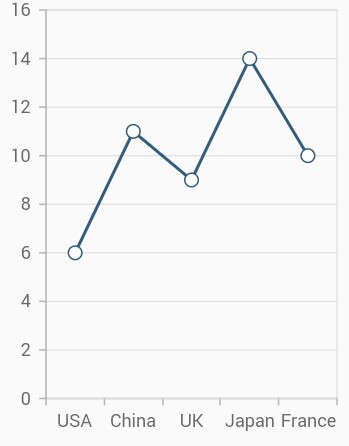
Customizing marker shapes
Markers can be assigned with different shapes using the shape property. By default, markers are rendered with DataMarkerType.circle shape. The available shapes of markers are listed below.
- circle
- rectangle
- image
- pentagon
- verticalLine
- horizontalLine
- diamond
- triangle
- invertedTriangle
@override
Widget build(BuildContext context) {
return Scaffold(
body: Center(
child: Container(
child: SfCartesianChart(
primaryXAxis: CategoryAxis(),
series: <CartesianSeries>[
LineSeries<ChartData, String>(
dataSource: chartData,
xValueMapper: (ChartData data, _) => data.x,
yValueMapper: (ChartData data, _) => data.y,
markerSettings: MarkerSettings(
isVisible: true,
// Marker shape is set to diamond
shape: DataMarkerType.diamond
)
)
]
)
)
)
);
}
class ChartData {
ChartData(this.x, this.y);
final String x;
final double? y;
}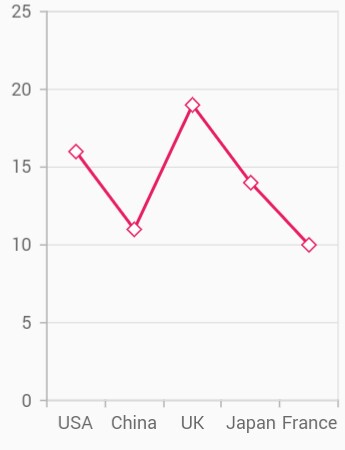
Image marker
The markers can be rendered with desired image as shape. For this you have to specify the shape as DataMarkerType.image and provide the image using image property.
@override
Widget build(BuildContext context) {
return Scaffold(
body: Center(
child: Container(
child: SfCartesianChart(
primaryXAxis: CategoryAxis(),
series: <CartesianSeries>[
LineSeries<ChartData, String>(
dataSource: chartData,
xValueMapper: (ChartData data, _) => data.x,
yValueMapper: (ChartData data, _) => data.y,
markerSettings: MarkerSettings(
isVisible: true,
shape: DataMarkerType.image,
// Renders the image as marker
image: const AssetImage('images/livechart.png')
)
)
]
)
)
)
);
}
class ChartData {
ChartData(this.x, this.y);
final String x;
final double? y;
}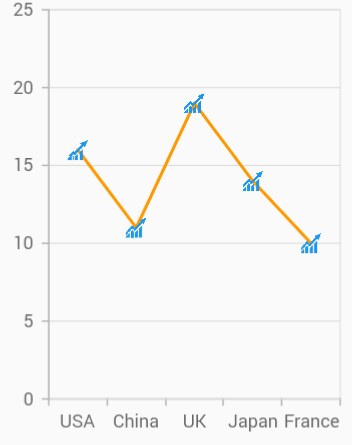
Data label
Data label can be added to a chart series by enabling the isVisible property in the dataLabelSettings. You can use the following properties to customize the appearance.
-
color- used to change the background color of the data label shape. -
borderWidth- used to change the stroke width of the data label shape. -
borderColor- used to change the stroke color of the data label shape. -
alignment- aligns the data label text toChartAlignment.near,ChartAlignment.centerandChartAlignment.far. -
textStyle- used to change the data label text color, size, font family, font style, and font weight. -
color- used to change the color of the data label. -
fontFamily- used to change the font family for the data label. -
fontStyle- used to change the font style for the data label. -
fontWeight- used to change the font weight for the data label. -
fontSize- used to change the font size for the data label. -
margin- used to change the margin size for data labels. -
opacity- used to control the transparency of the data label. -
labelAlignment- used to align the Cartesian data label positions. The available options to customize the positions areChartDataLabelAlignment.outer,ChartDataLabelAlignment.auto,ChartDataLabelAlignment.top,ChartDataLabelAlignment.bottomandChartDataLabelAlignment.middle. -
borderRadius- used to add the rounded corners to the data label shape. -
angle- used to rotate the labels. -
offset- used to move the data label vertically or horizontally from its position. -
showCumulativeValues- to show the cumulative values in stacked type series charts. -
labelIntersectAction- action on data labels intersection. The intersecting data labels can be hidden. -
labelPosition- position of the data label.
@override
Widget build(BuildContext context) {
return Scaffold(
body: Center(
child: Container(
child: SfCartesianChart(
primaryXAxis: CategoryAxis(),
series: <CartesianSeries>[
LineSeries<ChartData, String>(
dataSource: chartData,
xValueMapper: (ChartData data, _) => data.x,
yValueMapper: (ChartData data, _) => data.y,
dataLabelSettings: DataLabelSettings(
// Renders the data label
isVisible: true
)
)
]
)
)
)
);
}
class ChartData {
ChartData(this.x, this.y);
final String x;
final double? y;
}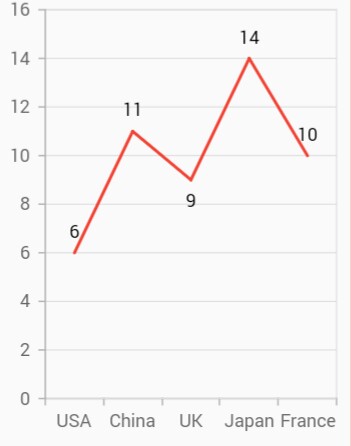
Formatting label content
Data label considers the format used in the vertical axis by default. In the below code snippet, we have specified format to y-axis and you can see that the same format is applied to the data label.
@override
Widget build(BuildContext context) {
return Scaffold(
body: Center(
child: Container(
child: SfCartesianChart(
primaryXAxis: CategoryAxis(),
primaryYAxis: NumericAxis(
// Applies currency format for y axis labels and also for data labels
numberFormat: NumberFormat.simpleCurrency()
),
series: <CartesianSeries>[
LineSeries<ChartData, String>(
dataSource: chartData,
color: Colors.red,
xValueMapper: (ChartData data, _) => data.x,
yValueMapper: (ChartData data, _) => data.y,
dataLabelSettings: DataLabelSettings(
isVisible: true
)
)
]
)
)
)
);
}
class ChartData {
ChartData(this.x, this.y);
final String x;
final double? y;
}
Import the following package to use label format in your application, import "package:intl/intl.dart";.
Label position
The labelAlignment property is used to position the Cartesian chart type data labels at ChartDataLabelAlignment.top, ChartDataLabelAlignment.bottom, ChartDataLabelAlignment.auto, ChartDataLabelAlignment.outer and ChartDataLabelAlignment.middle position of the actual data point position. By default, labels are ChartDataLabelAlignment.auto positioned. You can move the labels horizontally and vertically using OffsetX and OffsetY properties respectively.
@override
Widget build(BuildContext context) {
return Scaffold(
body: Center(
child: Container(
child: SfCartesianChart(
primaryXAxis: CategoryAxis(),
series: <CartesianSeries>[
AreaSeries<ChartData, String>(
dataSource: chartData,
xValueMapper: (ChartData data, _) => data.x,
yValueMapper: (ChartData data, _) => data.y,
dataLabelSettings: DataLabelSettings(
isVisible: true,
// Positioning the data label
labelAlignment: ChartDataLabelAlignment.top
)
)
]
)
)
)
);
}
class ChartData {
ChartData(this.x, this.y);
final String x;
final double? y;
}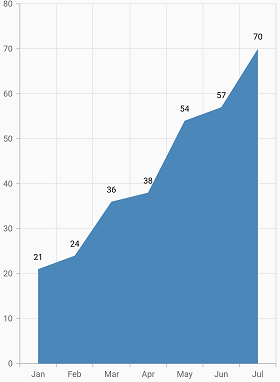
Apply series color
The useSeriesColor property is used to apply the series color to background color of the data labels. The default value of this property is false.
@override
Widget build(BuildContext context) {
return Scaffold(
body: Center(
child: Container(
child: SfCartesianChart(
primaryXAxis: CategoryAxis(),
series: <CartesianSeries>[
AreaSeries<ChartData, String>(
dataSource: chartData,
xValueMapper: (ChartData data, _) => data.x,
yValueMapper: (ChartData data, _) => data.y,
dataLabelSettings: DataLabelSettings(
isVisible: true,
// Positioning the data label
useSeriesColor: true,
)
)
]
)
)
)
);
}
class ChartData {
ChartData(this.x, this.y);
final String x;
final double? y;
}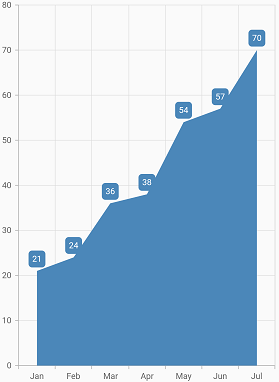
Point text mapping
The dataLabelMapper property is used to map the text from data source.
@override
Widget build(BuildContext context) {
final List<ChartData> chartData =[
ChartData('Jan', 21),
ChartData('Feb', 24),
ChartData('Mar', 36),
ChartData('Apr', 38),
ChartData('May', 54),
ChartData('Jun', 57),
ChartData('Jul', 70)
];
return Scaffold(
body: Center(
child: Container(
child:SfCartesianChart(
primaryXAxis: CategoryAxis(),
series: <CartesianSeries>[
AreaSeries<ChartData, String>(
dataSource: chartData,
xValueMapper: (ChartData data, _) => data.x,
yValueMapper: (ChartData data, _) => data.y,
// Map the data label text for each point from the data source
dataLabelMapper: (ChartData data, _) => data.x,
dataLabelSettings: DataLabelSettings(
isVisible: true
)
)
]
)
)
)
);
}
class ChartData {
ChartData(this.x, this.y);
final String x;
final double? y;
}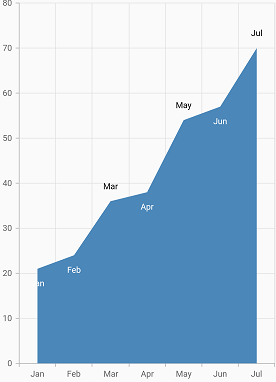
Label template
You can customize the appearance of the data label with your own template using the builder property of dataLabelSettings.
@override
Widget build(BuildContext context) {
return Scaffold(
body: Center(
child: Container(
child:SfCartesianChart(
series: <CartesianSeries>[
AreaSeries<ChartData, String>(
dataSource: chartData,
xValueMapper: (ChartData data, _) => data.x,
yValueMapper: (ChartData data, _) => data.y,
dataLabelMapper: (ChartData data, _) => data.x,
dataLabelSettings: DataLabelSettings(
isVisible: true,
// Templating the data label
builder: (dynamic data, dynamic point, dynamic series, int pointIndex, int seriesIndex) {
return Container(
height: 30,
width: 30,
child: Image.asset('images/bike.png')
);
}
)
)
]
)
)
)
);
}
class ChartData {
ChartData(this.x, this.y);
final String x;
final double? y;
}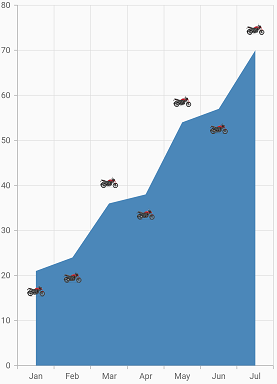
Hide data label for 0 value
Data label and its connector line in the Cartesian charts for the point value 0 can be hidden using the showZeroValue property. This defaults to true.
@override
Widget build(BuildContext context) {
return Scaffold(
body: Center(
child:SfCartesianChart(
series: <CartesianSeries<ChartData,num>>[
SplineSeries<ChartData, num>(
dataLabelSettings: DataLabelSettings(
showZeroValue: false,
isVisible: true
),
)
]
)
)
);
}
class ChartData {
ChartData(this.x, this.y);
final num x;
final double? y;
}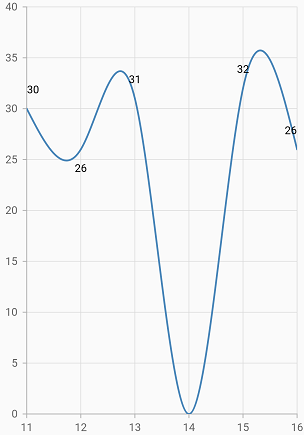
Data label padding
The offset property of dataLabelSettings can be used to add padding for the data label to move it in both vertically and horizontally direction from its position. It takes the logical pixel value for x and y values as input.
Note: This is not applicable for other widgets like Circular, Pyramid and Funnel charts.
Horizontal padding
In Horizontal padding, providing positive value for x moves the data label to “right” and negative value moves to “left”.
@override
Widget build(BuildContext context) {
return Scaffold(
body: Center(
child:SfCartesianChart(
series: <CartesianSeries<ChartData,num>>[
SplineSeries<ChartData, num>(
dataLabelSettings: DataLabelSettings(
isVisible: true,
offset: Offset(30, 0),
),
)
]
)
)
);
}
class ChartData {
ChartData(this.x, this.y);
final num x;
final double? y;
}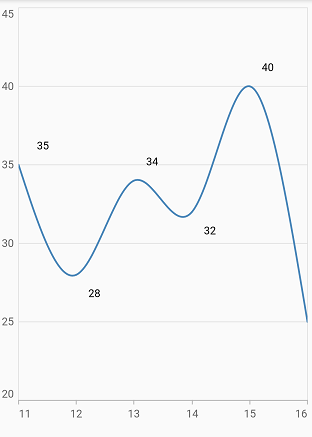
Vertical padding
In Vertical padding, providing positive value for y moves the data label upwards and negative value moves downwards.
@override
Widget build(BuildContext context) {
return Scaffold(
body: Center(
child:SfCartesianChart(
series: <CartesianSeries<ChartData,num>>[
SplineSeries<ChartData, num>(
dataLabelSettings: DataLabelSettings(
isVisible: true,
offset: Offset(0, 30),
),
)
]
)
)
);
}
class ChartData {
ChartData(this.x, this.y);
final num x;
final double? y;
}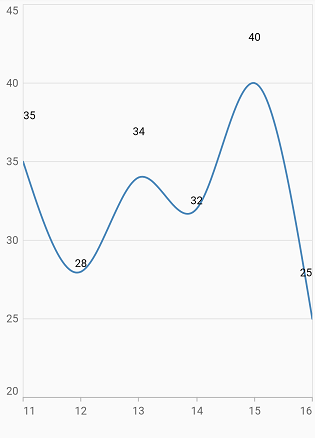
Data label saturation color
If the user didn’t provide text color to the data label, then by default, the saturation color is applied to the data label text. i.e., if the data points background color intensity is dark, then the data label will render in white color (#FFFFFF) and if the data points background color intensity is light, data label will render in black color (#000000).
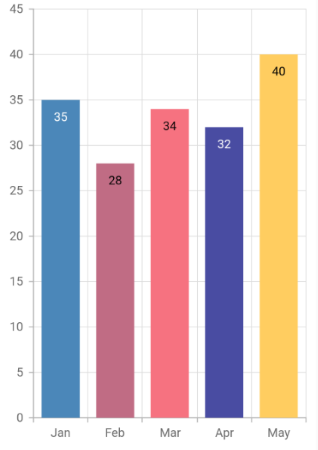
Note:
chartDatain the above code snippets is a class type list and holds the data for binding to the chart series. Refer Bind data source topic for more details.